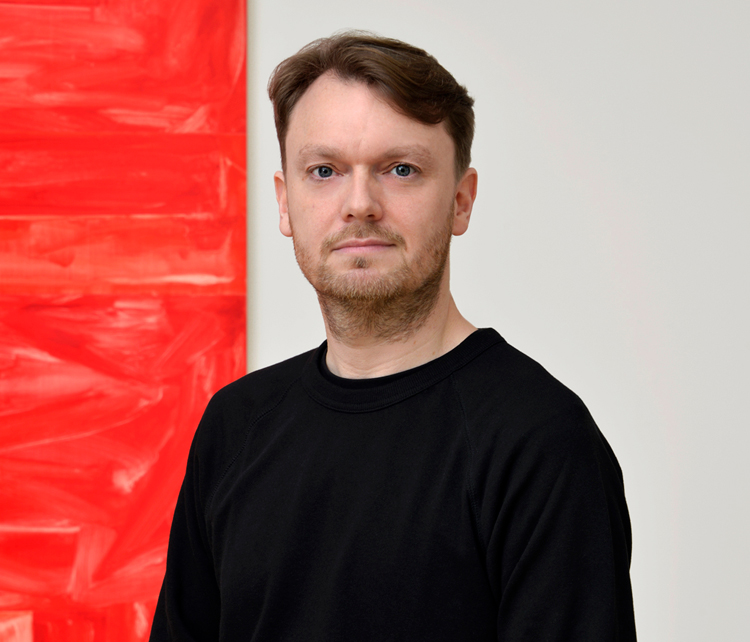
by DAVID TRIGG
The slick oil paintings of Robert Holyhead (b1974 Trowbridge) are hard-edged and exact; yet they are also loose and gestural. This delicate balancing act between precision and fluidity lies at the heart of his investigation into the possibilities of non-figurative painting.
Holyhead’s works are characterised by a distinctive visual language, in which freely brushed passages are punctuated by an austere geometry. A single semi-translucent colour fills the surface of each painting, with abstract gestures and marks coalescing around precisely defined shapes – forms that reveal the pure white of the carefully prepared oil ground below. These voids interrupt the surface colour, bringing your eye back to the materiality of the object. And yet each shape, whether rectangle, circle or oblong, is defined only by the brushwork surrounding it.
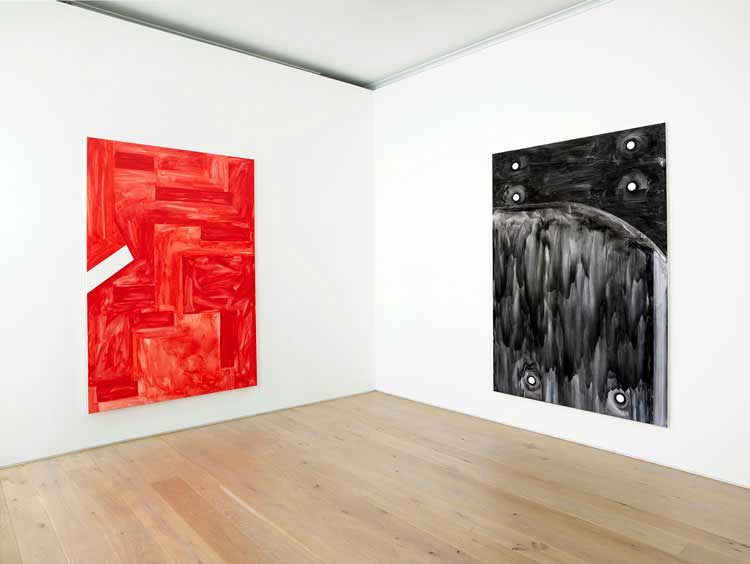
Robert Holyhead, No movement, no colour, Galerie Max Hetzler, London, 2019. Photo: Andrew Smart, AC Cooper Ltd. Courtesy of the artist and Galerie Max Hetzler, Berlin | Paris | London.
Holyhead’s canvases stem from his open-ended series of small watercolour drawings, a daily activity that functions as an evolving bank of possibilities and propositions from which ideas for the oil paintings emerge. Whereas the watercolours are quickly executed, each canvas is meticulously prepared over several months before painting can begin. After the layers of primer and immaculate white oil paint are dry, the final stage of painting is executed in an unusually small window of time, usually just a single day in the studio. Marks and gestures are repeatedly applied, wiped and washed back as Holyhead wrestles with the paint, coaxing and manipulating it into a coherent composition.
Studio International spoke to the artist at Galerie Max Hetzler, London, where his solo exhibition, No Movement, No Colour, presents a significant body of new oil paintings on a dramatically increased scale. In this interview, he discusses the role of his watercolour drawings, his considered approach to making paintings and the challenge of completing them in a single day.
David Trigg: There are two aspects to your practice: your small watercolour drawings and larger oil paintings on canvas. What is the relationship between these two ways of working?
Robert Holyhead: Each way of working has its own space. They’re not hierarchical, so the watercolours don’t act as maquettes or studies for the paintings. Of course, there’s always crossovers – things I figure out in the watercolours might start to be teased out in the works on canvas. Yet the watercolours aren’t provisional, they’re still concluded as objects, but it’s a very different process from the oil paintings. With the watercolour drawings, I’m making a positive mark that can’t be removed, whereas in the paintings there’s more openness in terms of how I might wipe back certain areas and reposition things.
DT: The watercolours seem to function quite differently from the paintings.
RH: Yes, they started years ago as a way of creating a space of ongoing investigation and building a vocabulary of possibilities where I didn’t need to think about any kind of conclusion or endpoint. The project is open-ended, a fluid bank of ideas that can be added to and rearranged. It’s an everyday practice that is about recording, observing and recalling visual encounters that I’ve come across, either in the world or in the studio. Also, the watercolours don’t need any preparation and each work is completed relatively quickly. Mistakes aren’t as costly as they are with the oil paintings. In that way, they are perfect for an investigation because you want the freedom to make mistakes. If you’re worried about making mistakes, then it’s very hard to introduce innovation.
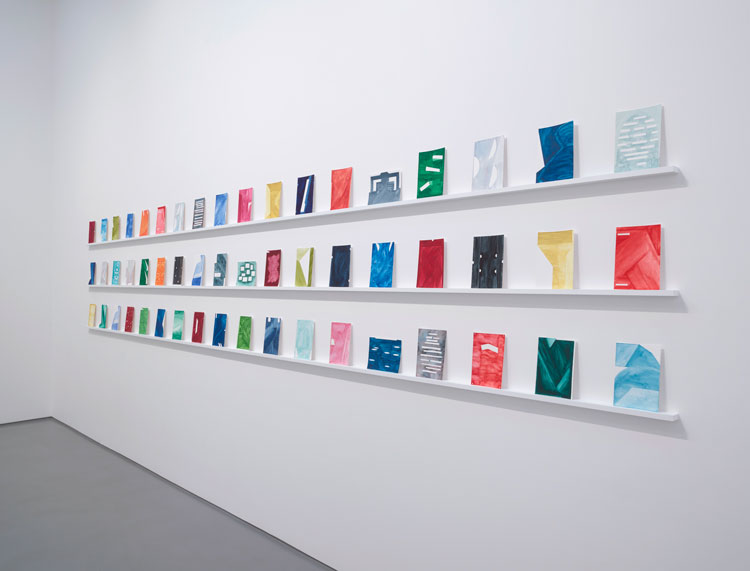
Installation view, Robert Holyhead, Galerie Max Hetzler, Paris, 2016. Photo: def_image. Courtesy of the artist and Galerie Max Hetz-ler, Berlin | Paris | London.
DT: I saw some of the framed watercolours in the office here at Galerie Max Hetzler, but you have decided not to include any in the main show.
RH: In my 2016 show at Max Hetzler’s Paris space, I did a very big installation of watercolours, which comprised 54 drawings on three, 5-metre-long shelves. I think to really make an impression with the watercolours, they need to be seen as a large group of possibilities. Showing them in a more restrained way is fine when they’re framed, but the ideal situation is to put them on shelves, which is how they operate in the studio, as a way of showing their function. In the current exhibition, I wanted to concentrate on the increased scale of the works on canvas, because that is something I haven’t presented before.
DT: And is it important that the watercolours are seen together in groups?
RH: They can be seen individually, as individual objects, but they generally operate as an ensemble. Yet each one has its own conditions and each one is a singular investigation.
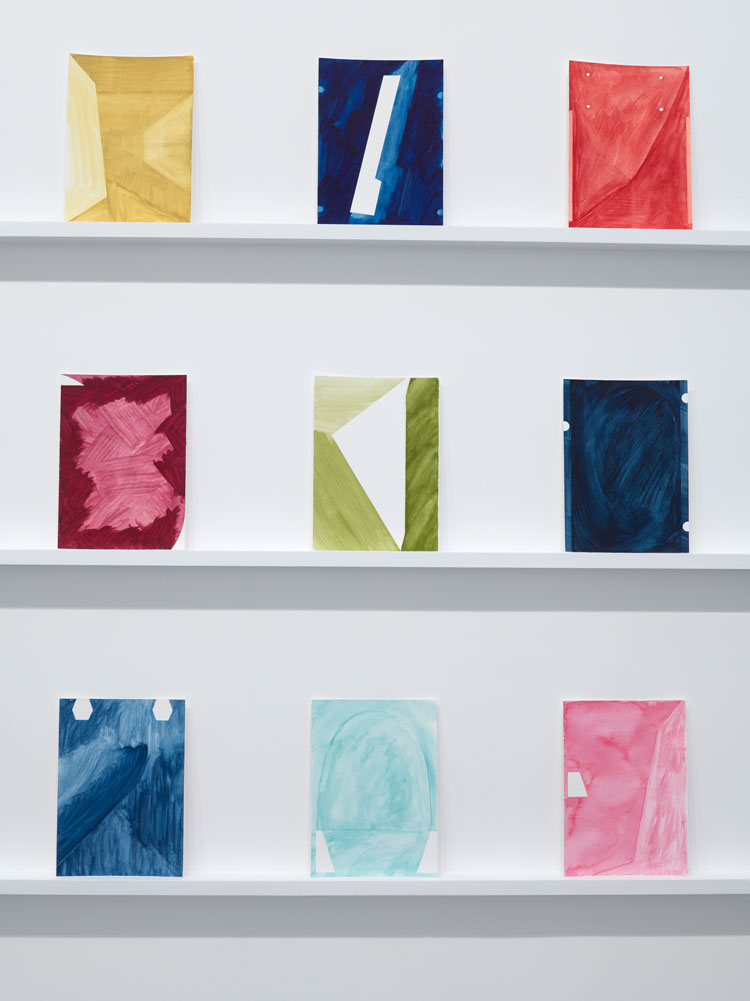
Installation view, Robert Holyhead, Galerie Max Hetzler, Paris, 2016. Photo: def_image. Courtesy of the artist and Galerie Max Hetz-ler, Berlin | Paris | London.
DT: Are they always the same size?
RH: Yes. It was one of those early decisions I made. I don’t think there was a strategy to that. I think it just came down to how many pieces of paper I could cut from a sheet of watercolour paper. So it was about efficiency – a pragmatic decision.
DT: And you refer to them as drawings rather than paintings?
RH: Yes, because they operate in terms of how I see drawing, which is about figuring things out.
DT: Your works on canvas combine two very different approaches to abstract painting. The gestural, semi-translucent passages are unashamedly painterly, yet the hard-edged geometric shapes seem to almost negate this painterliness.
RH: They are both reliant on each other. Without the hard-edge forms, the gesture becomes far too indulgent for me. But if it was all hard edge, the relationship to painting would feel too distanced. So there’s a to and fro, and I’m trying to create a space between those two positions.
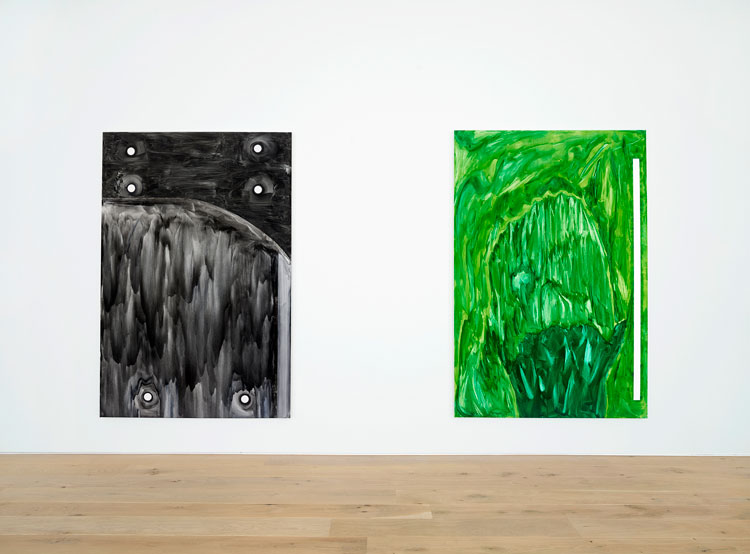
Robert Holyhead, No movement, no colour, Galerie Max Hetzler, London, 2019. Photo: Andrew Smart, AC Cooper Ltd. Courtesy of the artist and Galerie Max Hetzler, Berlin | Paris | London.
DT: The geometric forms are like negative spaces, punctuations that speak to absence or muteness.
RH: They speak to the absence of conclusion; they speak about the paintings remaining open and not being fully closed. I’m interested in how painting stays active and how, as a painter, I’m not searching for a conclusion to the project. The works are a series of layered possibilities and the geometric forms – you could see them as holes or interruptions – work differently in each painting; sometimes they’re markers, or sometimes a call to order, either back to the materiality of the object, the ground of the painting, or to a type of abstract mode.
DT: And yet the surface you are achieving is very flat, so even though you have these gestural marks, there is no impasto.
RH: No, it’s a very shallow space. I don’t want the painting to build up into an impastoed space, I’m looking for fluidity and a lightness of touch. That comes from the earlier watercolours that dealt with the materiality of paint in a very light way, where it could still represent a certain depth and hold itself as a colour and a material without the physical weight of the paint. I felt there was a liberation in that.
DT: These new paintings are completed in a single sitting. Do you see them in some way as extended gestures?
RH: Yes, I see each painting as a single, emerged gesture.
DT: Are there certain effects or marks you are trying to achieve, or is it all very intuitive?
RH: It’s relatively intuitive, but, essentially, what I’m looking for is fluidity, and allowing the surface to absorb all those painterly moments. I apply the paint with large varnish brushes and then rags and all sorts of things; the medium in the paint dries quite quickly so you have to work fast. Then there’s a lot of removing pigment and washing of the surface. It’s about constantly moving the material around until it starts to emerge in the right way. I mix specific colours and then those are let down in glaze mediums of different concentrations and applied to the surface. If it’s too dense, and it often is, I wash out the painting with pure glaze medium. I have no idea of what’s going to happen to the painting until I’ve put a hit of colour on it. Then it’s about editing on the surface.
DT: To what extent is negation important to the work?
RH: Negation is something I dealt with years ago at college and it still exists in my paintings, but in a more oblique way. I used to paint things out by adding material to negate, rather than removing material. Now I remove paint as a way of negating the weight of the compositions in some way. It’s a less confrontational form of negation.
DT: I’m interested in the geometric forms, which, in the new paintings are mostly rectangular. What informs these shapes?
RH: They operate within a vocabulary of familiarity. So they often relate back to certain architectural things that I see in the world, like gaps between buildings, slits in windows, or punctuations in surfaces – the banal forms of the day-to-day world, a hinge or bracket, for instance. They relate to functionality rather than decorativeness and they provide a counterpoint to the gestural areas.
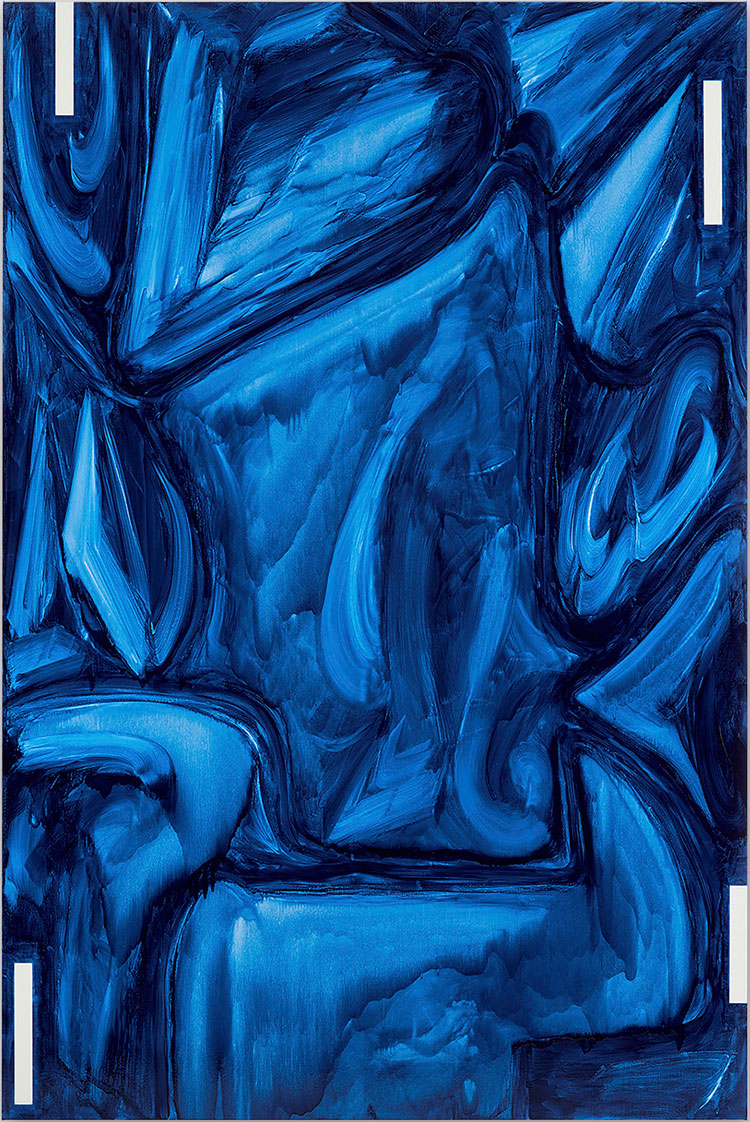
Robert Holyhead, Force, 2019. Robert Holyhead, Force, 2019. Photo: Jonathan Bassett © Robert Holyhead. Courtesy of the artist and Galerie Max Hetzler, Berlin | Paris | London.
DT: In some works, such as Force (2019), the rectangles are positioned extremely close to the edge of the painting, almost touching it.
RH: Yes, a couple of millimetres from the edge. I’m always looking to see how far I can push these interruptions. They are about testing the space and creating a tension in the painting. I think if that particular form went off the edge, then it wouldn’t be as interesting to me.
DT: The geometric forms appear to have been masked off, the lines are so crisp.
RH: No, they’re not masked off, they’re templated, which is a very different scenario. With masking, you would put tape down, paint over it and then peel it off. But I’ve never been interested in that because it’s too much of a convention. Even if you do it perfectly, you may get a small bleed or a ridge. Instead, I attach pieces of paper to the surface and then brush out from them, so I get a very crisp, almost clinical edge in relation to the fluidity of the paint. If you look closely at the surfaces, you can see that I’m working around these forms and the gesture emerges from them. At no point does a gesture move through them.
DT: What determines your colour choices?
RH: Colour is both suggestive and personal. It can be objectively suggestive in some ways, in that it can lead to notions of landscape and other things, or it can be quite manufactured and industrial. I try to work against my own sense of colour, or against the last group of colours I used. Often the colour is informed by the watercolour drawings, but obviously the translation from watercolour to oil paint is very different. You could say that I’m simply trying to surprise myself with colour.
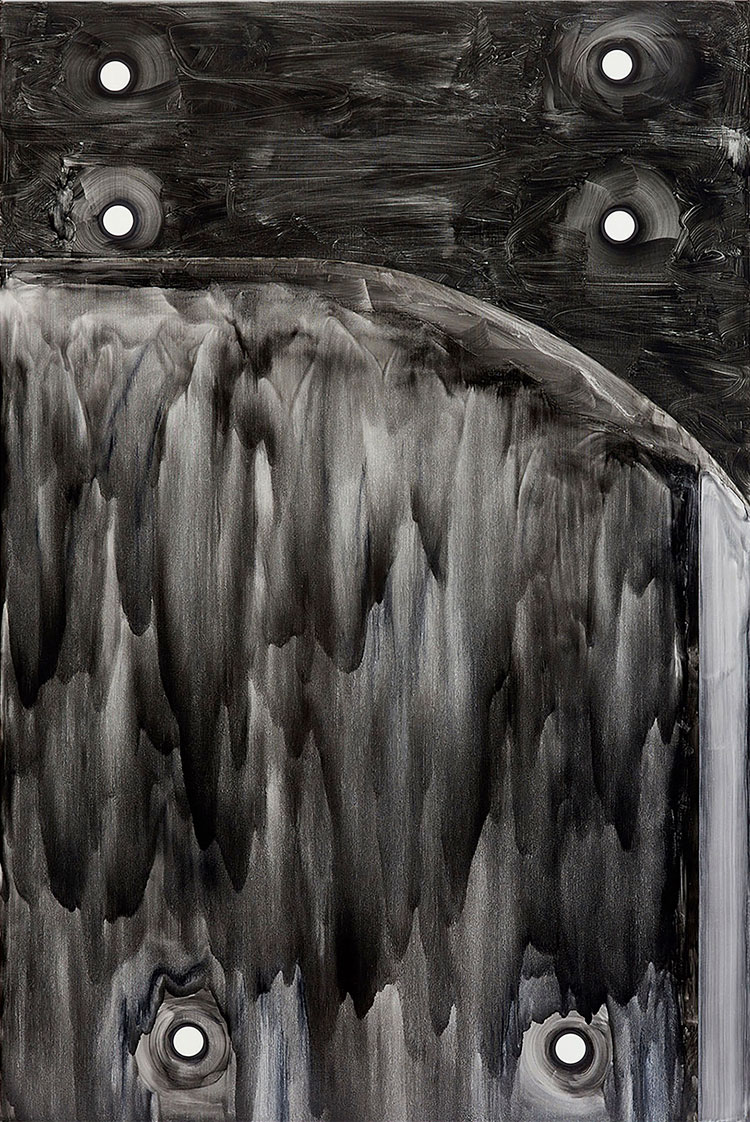
Robert Holyhead, Turn, 2019. Photo by Jonathan Bassett. © Robert Holyhead. Courtesy of Galerie Max Hetzler, Berlin, Paris, London.
DT: How long will you spend mixing a colour?
RH: I can spend five minutes to several hours, depending on the complexity of the colour. Some of the mixed greys you see in this show have no black in them. The painting Turn (2019) is primarily made of black but Still and Shape (both 2019) are made with mixed greys, using yellow, red, green and blue. Those are very interesting and quite complicated colours to mix; they could be a bit greener, a bit bluer, colder, warmer, and those incremental shifts can really change how a painting is delivered.
DT: You have said that the gestural marks are largely intuitive, but presumably you have to commit to the geometric shapes at the start of the painting process?
RH: Yes, there is a commitment because the geometric forms allow the rest of the painting to emerge. Some of those gestural marks are contingent on the form being there at the beginning. As I said, I’m not painting through the forms, I’m painting around them, and then that activity informs the next space of the painting. It’s like a chain reaction.
DT: You speak of poise or a delicate balancing act in relation to the making process; how do you know when a painting is finished?
RH: I could essentially go on for ever, re-editing and re-editing, but in some ways the painting decides when it is finished. I paint them in a day and I’ve found that there is a point at which both the painting and I become fatigued by each other; my body becomes fatigued and it’s like anything, you need a break from the activity. But there is a sort of synergy between me getting exhausted by the activity and the painting stopping before it becomes over-laboured.
DT: And do paintings sometimes fail?
RH: Yes, of course failures happen, but before that point I’m wrestling with them, pushing them to the edge. If they fail, it is only at the very end; they don’t fail halfway through. And it is in those moments of possible failure that you find something interesting. If I was to give up at lunchtime, then I wouldn’t know if I’d pushed it to the edge. The only time they fail is when they just completely collapse, or I realise I got the colour wrong. If the colour is wrong, then it’s all over because colour is so much a part of that delicate balance, or poise. It’s very frustrating because the last thing you want to do is add another colour in because it will affect the first colour.
DT: Are you using the same colour throughout the whole process, or are you occasionally bringing in extra pigments?
RH: Each painting has a main colour, but there are points during the painting process where it won’t be doing everything it needs to do, so sometimes I bring in other colours. Often, they’ll be subtle variations of the first colour, but sometimes I throw in a completely different colour and wash it into the surface. In Turn, for example, there are elements of blue in there and in the bottom half of the painting I washed in several different colours to try and make it work in opposition to the top half.
DT: Your latest works have dramatically increased in scale. What led you to this shift?
RH: The shift in scale came because habit had crept into the studio and I’d become overly familiar with the space of the smaller works. Also, I felt that my vocabulary was being limited and so shifting the scale became the obvious thing to do. The larger format has allowed me to be more generous to myself, to my practice and the medium. But they are not heroic because it was important that the painting still retained a type of intimacy.
DT: You execute the paintings within a small timeframe, usually just a single day. Was that a pragmatic decision related to paint drying times or is it a self-imposed limitation, a personal challenge?
RH: It’s all of those. Again, it’s related to the watercolours and wanting to keep a lightness and fluidity to the work. But it’s also pragmatic, because you can only work the paint for so long before it dries. Also, I’m not interested in going home, having dinner, having a good night’s rest and then coming back to the same painting the next day. It would change the relationship I have with the painting – I want to experience the start, the middle and the end all in one moment. Typically, I will paint from 10am up to about 2am. It gets pretty tiring, but I want to walk away from the painting knowing that it has reached the limit of its possibility, and I’ve reached the limit of my time with it. It’s a reaction against paintings I’ve made in the past that were over-laboured, which is something I really want to avoid. It’s about keeping the painting fresh and alive and not going back and tinkering with it. The doubts should be a part of the day, not the next day.
DT: It sounds like a good cure for perfectionism.
RH: Well, I think I am a perfectionist, which comes from trying to control things too much. To a certain degree, I still want to indulge my perfectionism because I think it adds something to the work, but at the same time I need to allow the other side to exist. And in that combination, that’s where the paintings come out, and that’s why painting makes sense to me.
DT: And the paintings do reflect that; they balance these moments of perfectionism with something that’s looser, less controlled and freer. But before you begin to paint, the preparation time is quite protracted isn’t it?
RH: Yes, it’s very involved and very pre-planned. I’ll decide on a scale and prepare 10 or 15 surfaces all at the same time, very methodically. They have to dry out for about three months because I’m using a traditional oil ground, which has to dry and cure fully before I can start painting on it. If I rush it and the ground is still soft, when I start adding the solvent, the surface will just flake, so it has to be properly solid. But in between preparing surfaces and waiting for them to dry, I’m working on the drawings. I’m probably only making one group of paintings a year, but, with the drawings, I’ll produce about 200 to 300 a year.
DT: Your work is often described as abstract or non-figurative, but how useful are these labels in describing what you are doing?
RH: The simplest way of describing what I’m doing is making paintings. The use of the word abstract is a convenience to the discourse surrounding my work, but I don’t set out to make abstract paintings. However, I’m very curious about abstract space.
DT: To what extent, then, do you see yourself as belonging to a particular history of painting?
RH: I don’t really. I see myself within maybe a particular contemporary moment in painting, one that isn’t defined by any type of grand narrative. I’m interested in notions of doubt and uncertainty in the space of painting and how one deals with that in the studio, on the surface, instead of just talking about it. One of the things I never wanted to do was to make paintings that were representations of painting. I’ve seen a lot of paintings that are just merely representations of a theory of painting and that’s something I’ve wanted to try and avoid.
DT: I think you’ve achieved that, but you are taking a risk because you are using all this gesture – a few wrong moves and you might end up with a painting that looks as if it is trying to be a painting.
RH: This is exactly the risk that keeps me interested – the extent to which I can control it, or indulge it without it tipping over the edge. If you’re self-aware enough you can operate constraint, and that is something essential to each painting.
• Robert Holyhead: No Movement, No Colour is at Galerie Max Hetzler, London, until 11 January 2020.